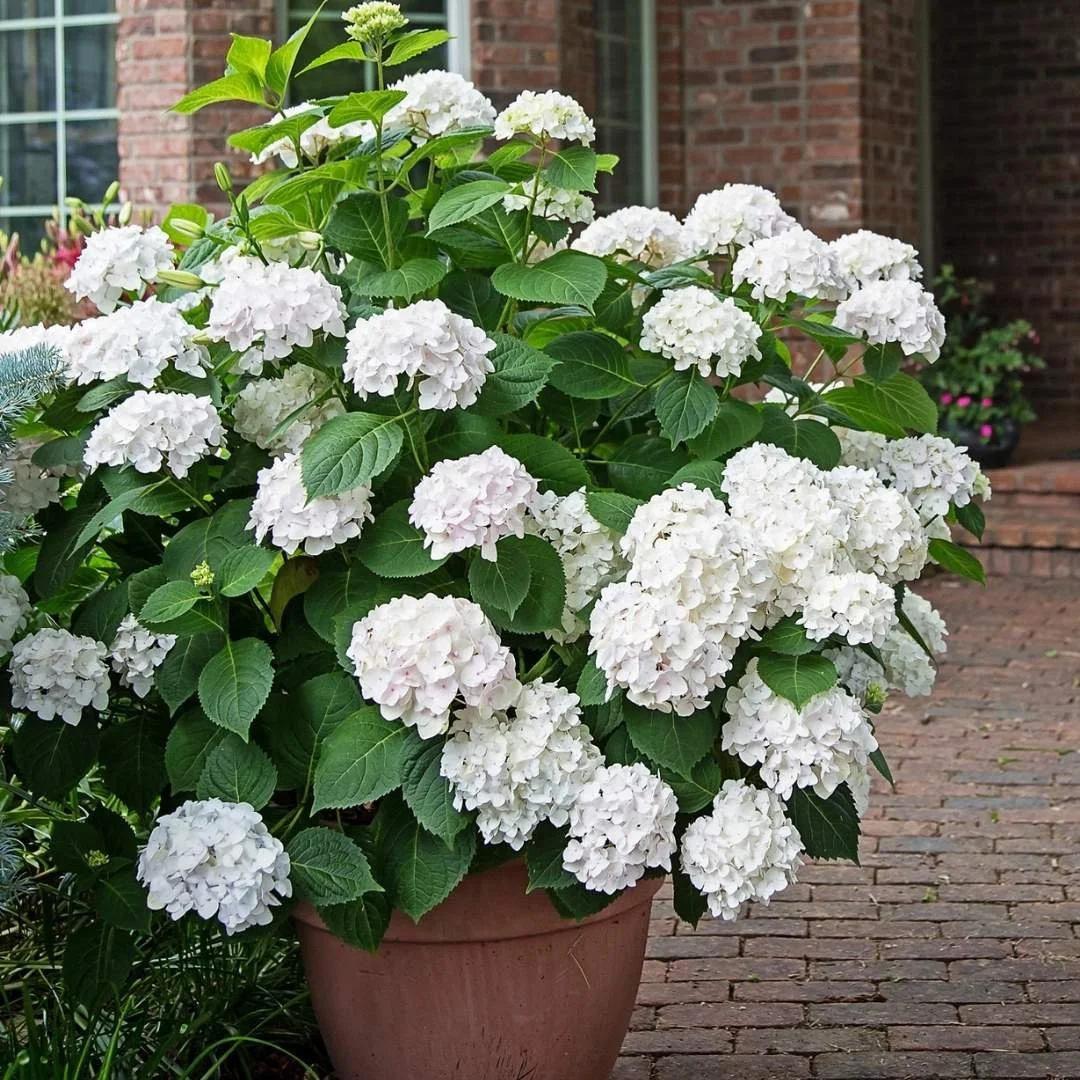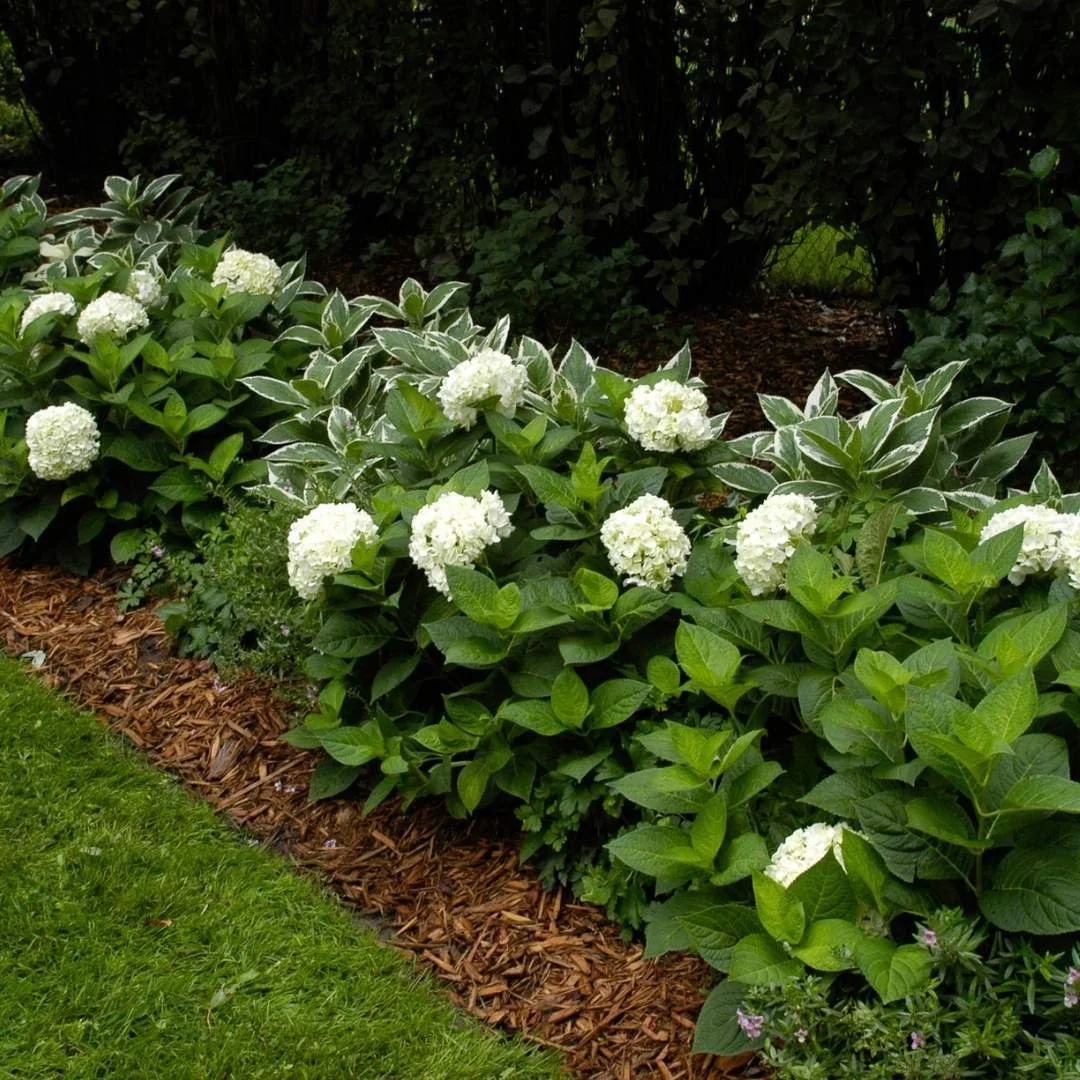Endless Summer® Blushing Bride Reblooming Hydrangea
Elegant white flowers give this mophead hydrangea classic charm.
The Endless Summer® Blushing Bride Reblooming Hydrangea (Hydrangea macrophylla ‘Blushing Bride’) is a cultivated variety of the bigleaf hydrangea, a deciduous shrub from Asia belonging to the Hydrangeaceae family.
Blushing Bride is part of the Endless Summer® collection of reblooming hydrangeas, and was introduced to the market in 2006.
It stands apart for having pure white double flowers, dark green foliage, and the ability to rebloom throughout the summer.
Blushing Bride is an upright, rounded shrub with large mophead flowers. The flowers emerge white in spring and take on a blush pink or soft purple-blue tinge as the summer progresses, depending on the pH of the soil.
The white flowers of Blushing Bride Reblooming Hydrangea are a great choice for the front of the house and won’t clash with orange and red toned bricks. Image courtesy of Bailey Nurseries.
It’s a moderately fast growing hydrangea, adding 13 - 24 inches of growth per year until it reaches a mature size of 3-6 feet tall and wide.
Blushing Bride has the ability to bloom on both old and new wood, flowering repeatedly from late spring through fall despite extreme winter cold snaps and unpredictable spring freezes.
It grows in zones 5-9 and prefers part shade and rich, well-draining soil (winter protection is recommended in zone 5). A location with morning sun and dappled afternoon light is ideal.
Deer will eat hydrangea flower buds and leaves, especially the tender young growth.
If you would like to grow a flowering shrub that deer tend to leave alone, try Ruby Spice summersweet clethra as a deer resistant alternative to the bigleaf hydrangea.
Read on to discover how to grow and care for this elegant white hydrangea, and get landscaping and companion planting ideas.
What is a Reblooming Hydrangea?
A reblooming hydrangea blooms on both old and new wood, giving it the ability to produce flowers repeatedly throughout the growing season.
The Blushing Bride hydrangea produces its first flush of blooms from buds that were set in the previous year; subsequent flowers emerge later in the summer from buds that form on the current season’s growth.
Reblooming hydrangeas are also called remontant hydrangeas.
Does Blushing Bride Hydrangea Stay White?
The semi-double flowers of Blushing Bride hydrangea starts out brilliant white and develop a soft, subtle tinge of blush pink or purple-blue as the flowers mature.
Flower color depends on the pH of the soil, with basic soil producing a blush pink tinge and basic soil giving blooms a purple-blue tinge.
Flowers will always start out white, and subsequent changes are very soft and muted.
The flowers of the Endless Summer® Blushing Bride Reblooming Hydrangea emerge white and turn blush pink or light blue as the growing season progresses. Image courtesy of Bailey Nurseries.
How to Plant and Grow Blushing Bride Reblooming Hydrangea
Planting: The best time of year to plant a Blushing Bride hydrangea is in the spring or fall, giving the roots time to establish before the onset of extreme hot or cold weather. Water deeply immediately after planting. Blushing Bride is a popular hydrangea and has a tendency to sell out quickly, so visit the nursery in early spring for the best selection!
Location: Choose a location with well-drained soil that is rich in organic matter. Blushing Bride prefers soil that retains moisture but does not become waterlogged. Select a spot with partial shade and protection from the intense afternoon sun.
Soil: Amend the soil with organic matter, such as compost or shredded leaves, to improve drainage and soil fertility. If you want Blushing Bride to take on either pink or purple-blue hues, consider getting a soil test and adding sulfur or lime to the soil. Add sulfur for a purple-blue tinge and lime for a blush of pink.
Mulch: Apply a layer of organic mulch around the base of the plant to retain soil moisture, regulate temperature, and suppress weeds. Make sure the mulch does not touch the base of the plant.
Watering: Keep the soil consistently moist but not waterlogged, especially during periods of drought. Deep watering is preferable to encourage the development of a strong root system (Are you in a drought? Check the U.S. Drought Monitor).
Fertilization: Hydrangeas typically do not need fertilization when they are given the rich, fertile soil they prefer. Each spring, spread a layer of compost, shredded leaves or Leaf-gro® around the base of your hydrangea, being careful to keep away from the base of the shrub.
Pruning: Blushing Bride hydrangeas require little to no pruning - if you prune too much, you risk cutting off buds that will eventually become flowers. In spring, cut out dead canes once new growth has emerged. If you must prune back a Blushing Bride hydrangea for size, cut back by no more than half in late summer.
Pest and Diseases: Blushing Bride hydrangeas are prone to powdery mildew, anthracnose, aphids and spider mites. Ensure good air circulation around your plants to minimize the risk of disease, and practice good watering habits (see “How to Water your Plants” to brush up on your watering skills).
Do Blushing Bride Reblooming Hydrangeas like Sun or Shade?
The Blushing Bride Reblooming Hydrangea thrives in part shade and does best with 2-4 hours of direct sunlight per day.
Blushing Bride prefers morning sun and dappled or filtered afternoon shade with protection from the intense rays of afternoon sun, particularly in hotter climates.
Planting Companions for Blushing Bride Reblooming Hydrangea
Feeling inspired to plant a Blushing Bride hydrangea in your garden? Here are some ideas for planting companions - all favor the same partial shade conditions and moist, rich, well-draining soil that bigleaf hydrangeas love:
Dwarf Globe Blue Spruce (Picea pungens ‘Globosa’): This small, dense evergreen shrub has blue-green needles that contrast nicely with the large leaves of Blushing Bride.
Spreading Japanese Plum Yew (Cephalotaxus harringtonia ‘Prostrata’): This shade-loving, heat tolerant needled evergreen forms a carpet of green and helps to highlight the large leaves and white flowers of Blushing Bride.
Himalayan Sweet Box (Sarcococca hookeriana var. humilis): A low-growing evergreen ground cover for the shade. Its glossy dark green leaves are the perfect complement for Blushing Bride.
NewGen Freedom® Boxwood (Buxus NewGen Freedom® ‘SB 300’): The small leaves and structured shape of boxwoods are the perfect evergreen companion for bigleaf hydrangeas. Freedom® boxwoods have a uniform, tight rounded habit and improved resistance to boxwood leafminer.
Astilbe (Astilbe species.): The fine textured foliage and spiky summer flowers of astilbe are a great partner for Blushing Bride hydrangeas. Pink-tinged varieties like ‘Peach Blossom’ look particularly nice.
Variegated Solomon’s Seal (Polygonatum falcatum ‘Variegatum’): This slow-growing perennial with variegated leaves and arching stems pairs nicely with Blushing Bride.
Jack Frost Siberian Bugloss (Brunnera macrophylla ‘Jack Frost’): The silvery-green foliage and airy blue flowers of this shade-loving perennial contrast with Blushing Bride’s dark green leaves.
Japanese Painted Fern (Athyrium niponicum 'Pictum'): Dramatic blue-green-silver foliage and a short stature make this fern a great choice to use as a facer plant in front of Blushing Bride.
Garden Design Ideas for Blushing Bride Reblooming Hydrangea
Foundation Planting: Plant Blushing Bride hydrangeas along side the foundation of your house. Their elegant flowers and lush green foliage will enhance the curb appeal of your home.
Mixed Borders: Create a mixed border planting by combining Blushing Bride with other complementary perennials, ornamental grasses, deciduous and evergreen shrubs for four seasons of color and texture.
Mass Planting: Plant Blushing Bride hydrangeas in groupings to create a mass of color. This approach works well in large garden beds or alongside pathways and fences, providing a striking visual impact.
Woodland Garden: The dappled shade underneath the canopy of tall trees is an ideal spot for a Blushing Bride hydrangea. Combine with other partial-shade loving plants like camellias, Japanese andromeda, azaleas, and rhododendrons.
Accent Planting: Use Blushing Bride as a focal point in the landscape. Plant strategically to draw attention to specific areas of the garden, like entryways, water features, pathways, seating areas, or garden sculptures.
Containers: With its graceful pure white flowers, Blushing Bride is a natural fit for decorative pots and planters. Pair with spillers like sweet potato vine and trailing lobelia.
Variegated hosts make a great companion planting for the Blushing Bride hydrangea. Image courtesy of Bailey Nurseries.
Are Blushing Bride Reblooming Hydrangeas Poisonous to Dogs?
Blushing Bride Reblooming Hydrangeas (Hydrangea macrophylla ‘Blushing Bride’) contain compounds that can be toxic to dogs if ingested, specifically cyanogenic glycosides.
These compounds can release cyanide when broken down in the digestive system.
However, the level of toxins in bigleaf hydrangeas are relatively low, and instances of dogs getting poisoned by consuming these plants are rare.
While the risk of severe poisoning is low, it’s important to monitor your dog's behavior in outdoor spaces.
If you suspect your dog has ingested a toxic plant, seek immediate veterinary care or contact the Pet Poison Hotline.
Read “Which Plants are Toxic to Dogs” for more information on plants poisonous to dogs.
Why isn’t My Blushing Bride Hydrangea Blooming?
It can be quite disappointing when your hydrangea fails to bloom, especially when you've been eagerly anticipating its striking white flowers. Several factors could contribute to its lack of blooms:
Improper pruning: Did you prune your Blushing Bride hydrangea? You may have cut off flower buds that would eventually become flowers. This hydrangea requires little to no pruning. Never hard prune Blushing Bride, and never prune in the fall or you will risk losing future blooms.
Young plant: Hydrangeas may take a few years to establish before they start blooming. If your plant is still relatively young, it might just need more time to mature and establish itself - be patient!
Insufficient sunlight: For best flowering, Blushing Bride hydrangeas need at least 2-4 hours of direct sunlight per day. If they're not getting enough sunlight, they may produce fewer blooms or fail to bloom altogether.
Watering issues: Inconsistent or inadequate watering can stress the plant and affect flowering. Ensure your hydrangea receives sufficient water, especially during hot and dry periods.
Deer: Deer like the taste of hydrangeas, particularly the flowers and buds. They may visit your yard and nibble the buds off of your hydrangea, leaving no evidence of their presence other than the absence of flowers.



